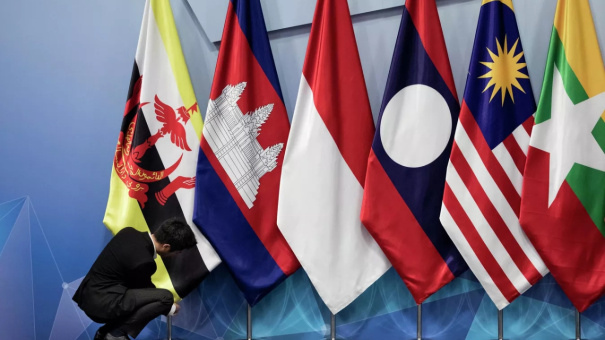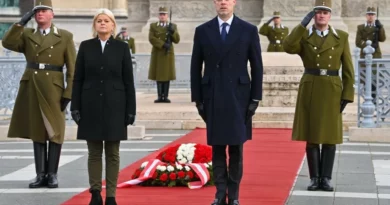The Empire Strikes Back: Color Revolutions in South and Southeast Asia
Source : katehon.com – August 22, 2024 – Pepe Escobar
https://katehon.com/en/article/empire-strikes-back-color-revolutions-south-and-southeast-asia
Abonnez-vous au canal Telegram Strategika pour ne rien rater de notre actualité
Pour nous soutenir commandez les livres Strategika : “Globalisme et dépopulation” , « La guerre des USA contre l’Europe » et « Société ouverte contre Eurasie »
The unipolar moment being progressively erased across Eurasia implies a frantic Empire counter-reaction of multiplying the color revolution front. Let’s focus here on South and Southeast Asia.
Last week Chinese Foreign Minister Wang Yi visited Myanmar and Thailand on two different missions.
In Myanmar, the mission was another mediating effort concerning the intractable clash between the Burmese-majority government in Naypyidaw and a loose alliance of dozens of ethnic minority rebel outfits, bearing all sorts of grievances. China keeps relations with some of them.
In Thailand, the mission was geoeconomic: meeting with the Mekong River states; chairing the 9th Lancang-Mekong Cooperation (LMC) Foreign Ministers’ Meeting; and discussing geoeconomics with diplomats from Laos, Myanmar, Thailand, Cambodia and Vietnam.
The LMC is quite ambitious: a regional cooperation mechanism launched in 2016, where the Chinese focus is to link the Lancang-Mekong region into what Beijing defines as “high-quality Belt and Road cooperation”. So this is all about BRI and the New Silk Roads.
While Wang Yi was in Southeast Asia, Thailand went through a roller-coaster, with a Prime Minister removed by the Constitutional Court and the arrival of a brand new one: Paetongtarn Shinawatra, the 37-year-old daughter of ultra-controversial billionaire tycoon Thaksin Shinawatra, who not only got a royal pardon but is now politically back with a bang.
Thaksin was back in Thailand for a while after 15 years of self-exile, as he fled the country claiming he could not get a fair trial for a tsunami of “politically motivated” charges.
Thai politics – a hyper-convoluted dance – is now leaning conservative all over again, with Thaksin leading his Peu Thai party against the reincarnation of the theoretically progressive Move Forward party, which was dissolved in early August.
All that action, at least for the moment, may prevent attempts at a color revolution. It depends on what happens in the next elections. What conservatives and monarchists call “liberals” may eventually end up controlling the political landscape – totally aligned with Washington and keen to disrupt close China-Thailand geopolitical and geoeconomic ties.
That Shaky Myanmar Ceasefire
In neighboring Myanmar, China had managed to sponsor a ceasefire in June. Yet the ceasefire collapsed – with senior military commanders “captured by terrorist insurgents” (in government terminology) in crucial Shan state. This is the first time rebels have managed to capture a regional command center.
Adding to the trouble, the military in this contested region are the Kokang Allied Forces, which happen to be the armed forces of Han Chinese in Myanmar. China is a major weapons supplier to the military junta running Myanmar.
No wonder this was a really big issue at last month’s ASEAN meeting. And it gets proverbially trickier, as the US – which hands out Starlink kits to the rebels for free – at the same time accuses Beijing of supporting them.
The key point is that the military in Naypyidaw simply cannot control the north of the fractured nation; so their strategy may be simply to ramp up anti-China sentiment. The relationship with China is immensely complex: a mix of fear, suspicion and much needed help for economic development.
Beijing of course treads very carefully when it comes to its geostrategically crucial neighbor – following the cherished principle of non-interference in internal affairs. China always sees ASEAN as a whole – and it already has its hands full with a series of provocations by the Philippines in the South China Sea.
Chinese military experts predictably describe these as « a petty attempt to constantly bolster Manila’s victimhood narrative » in the South China Sea. Needless to add, Washington fully encourages the narrative.
ASEAN Wants BRICS
China – as much as Russia – also regards ASEAN from a SCO perspective, focusing on the evolving, long-term process of a matrix of multilateral organizations shaping the emergence of a multi-nodal world.
And that brings us to the crucial meeting between Wang Yi and Sergey Lavrov during the East Asia summit in Laos in late July – where they forcefully reiterated their common drive towards establishing peace and stability across East Asia.
TAC is a really big thing, as it acknowledges “the importance of ASEAN centrality and unity in the evolving regional architecture in the Asia-Pacific built upon ASEAN-led mechanisms with ASEAN as the driving force, and based on international law.”
All that includes closer cooperation between ASEAN, SCO and the Eurasia Economic Union (EAEU). ASEAN signed memoranda of understanding with both SCO and EAEU.
And this interpolation of key nodes in the merging matrix of course also extends to BRICS.
Thailand is keen to join BRICS. Diplomatic circles confirmed last month that the “suggestion” came directly from the Thai monarchy. As for Malaysia, it has already formally applied to join BRICS. And Indonesia and Vietnam are also on the waiting list.
So it’s no wonder that Lavrov told Wang Yi that the Russia-China strategic partnership must work together to “jointly counter interference by forces from outside this region in the affairs of Southeast Asia”.
Wang Yi and Lavrov also discussed in detail cooperation within ASEAN, considering that, according to the Chinese Foreign Ministry, “certain countries have become increasingly proactive in setting up restricted bloc-based military and political mechanisms which are designed to undermine the ASEAN-centric security and stability framework for the Asia-Pacific region”.
In a nutshell, as stressed by Wang Yi: Russia-China and ASEAN are fully engaged in “coordination on East Asian cooperation”. It’s always crucial to remember that during the Cold War, Moscow actively supported nationalist, anti-colonial movements in Southeast Asia, especially in Vietnam and Laos.
Bangladesh in the Bag
Southeast Asia will continue to be the target of several color revolution attempts, and the focus of support for 5th columns, as in the Philippines case. In South Asia, the scenario may be even more acute – considering a color revolution has just been successful, with minimal effort.
What happened in Bangladesh is directly linked to the destabilization of Southeast Asia and the wider American obsession with the Indo-Pacific (the real, accepted denomination used by everyone across the continent is Asia-Pacific).
And most of all, this was a color revolution unleashed simultaneously against two BRICS: India and China.
The mechanism featured all proverbial time-tested shenanigans: direct involvement of the US ambassador to Bangladesh, Peter Haas; enormous pressure on the Sheikh Hasina government to hold elections assured of a US-friendly outcome; American mobilization behind the opposition Bangladesh Nationalist Party (BNP); funds and logistics supporting “pro-democracy” student protesters.
The fact is the BNP plus the Jamaat-e-Islami* – branded as a terrorist organization by several nations, including Russia – were the key destabilizing factors. It’s no wonder the US State Dept. pre-emptively characterized the Jammat-e-Islami as victims of government “abuses.”
No one beats the awesome American soft power apparatus when it comes to masterminding “protests” mingling crypto-terror outfits and harmless civil society groups. In Bangladesh it was very easy to manufacture a “vanguard”: a bunch of students from Dacca University’s political science department, especially one Nahid Islam.
Dacca University’s political science department is crammed with professors financed by a shady “Confronting Misinformation in Bangladesh” (CMIB) outfit. Two of these headed the project, complete with lavish NED grants.
And it was exactly these political science protesters/agit-prop agents at Dacca University that “proposed” Muhammad Yunusas the Chief Adviser of the next Bangladeshi government.
Yunus happens to be an American darling: State Dept. Fulbright scholar; Nobel Peace Prize; and “the first American Muslim recipient of a Congressional Gold Medal”, according to his organization, the Yunus Centre. By the way, he’s not even an American citizen.
Bangladesh is a golden trophy for the Hegemon. The internal destabilization is directly related to Myanmar, Dacca’s eastern neighbor, and progressively wider CIA-style subversion of a key BRI corridor: the Bangladesh-China-India-Myanmar corridor (BCIM).
In parallel, it will provide additional headaches for India in the Bay of Bengal. The American masterplan is to force BRICS member India to make serious concessions when it comes to its comprehensive energy/trade/military relationship with Russia, and to force closer India integration to Quad.
Then, of course, is the Holy Grail: establishing a NATO base in the island of St. Martin, fiercely resisted by the deposed Sheikh Hasina.
Cut to Primakov’s Triangle
The Bangladesh case reveals that the progressive integration of ASEAN – and South Asia – with the SCO/EAEU/BRICS/BRI matrix is more urgent than ever. An auspicious sign is that ASEAN, according to Lavrov, is already paying attention to Putin’s drive to build a Eurasia-wide unified security system.
At the end of the ASEAN-Russia session at the East Asian summit in Laos, Lavrov said that ASEAN “has shown interest in President Putin’s initiative, which I have already mentioned, on the formation of a Eurasian security system that would be indivisible and equal.”
Lavrov added that « our ASEAN partners understand perfectly well » how the West’s only goal is to contain Russia and China. That’s what was in effect in Bangladesh, and what will be attempted in Thailand and Myanmar.
The road will be long and thorny. But if the “RIC” in BRICS (Russia-India-China) do get their geopolitical act together and de facto renew the fabled Primakov’s triangle, the possibility of further successful color revolutions destabilizing several nodes of East Asia will vanish in the winds of time.
* terrorist organization banned in Russia.




